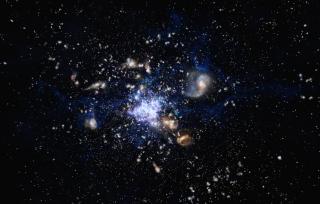Bibcode
Ding, Y.; Clements, D. L.; Leeuw, L. L.; Heywood, I.; Dannerbauer, H.; Parmar, A.; Legodi, P.; Ivison, R. J.; Blake, R.; Gutiérrez, C. M.; Carnero, A.; Sutherland, W.
Referencia bibliográfica
Monthly Notices of the Royal Astronomical Society
Fecha de publicación:
11
2024
Número de citas
0
Número de citas referidas
0
Descripción
High-redshift protoclusters consisting of dusty starbursts are thought to play an important role in galaxy evolution. Their dusty nature makes them bright in the far-infrared (FIR)/submm but difficult to find in optical/near-infrared (NIR) surveys. Radio observations are an excellent way to study these dusty starbursts, as dust is transparent in the radio and there is a tight correlation between the FIR and radio emission of a galaxy. Here, we present MeerKAT 1.28 GHz radio imaging of three Herschel candidate protoclusters, with a synthesized beam size of $\sim 7.5\, \mathrm{ arcsec}\times 6.6$ arcsec and a central thermal noise down to $4.35~\mu$Jy beam-1. Our source counts are consistent with other radio counts with no evidence of overdensities. Around 95 per cent of the Herschel sources have 1.28 GHz IDs. Using the Herschel$250~\mu$m primary beam size as the searching radius, we find 54.2 per cent Herschel sources have multiple 1.28 GHz IDs. Our average FIR-radio correlation coefficient $q_{250\mu \text{m}}$ is $2.33\pm 0.26$. Adding $q_{250\mu \text{m}}$ as a new constraint, the probability of finding chance-aligned sources is reduced by a factor of $\sim 6$, but with the risk of discarding true identifications of radio-loud/quiet sources. With accurate MeerKAT positions, we cross-match our Herschel sources to optical/NIR data followed by photometric redshift estimations. By removing $z< 1$ sources, the density contrasts of two of the candidate protoclusters increase, suggestive of them being real protoclusters at $z> 1$. There is also potentially a $0.9< z< 1.2$ overdensity associated with one candidate protocluster. In summary, photometric redshifts from radio-optical cross-identifications have provided some tentative evidence of overdensities aligning with two of the candidate protoclusters.
Proyectos relacionados

Gas Molecular y Polvo en Galacias através del Tiempo Cósmico
Dos cuestiones fundamentales en la Astrofísica son la conversión de gas molecuar en estrellas y cómo este proceso físico depende del entorno en todas las escalas, desde sistemas planetarios, cúmulos estelares, galaxias hasta cúmulos de galaxias. El objectivo principal de este proyecto es el de estudiar la formación y evolución de galaxias a partir
Helmut
Dannerbauer